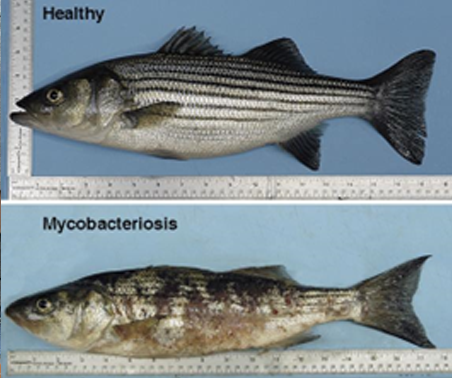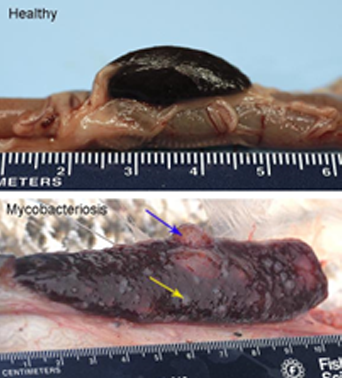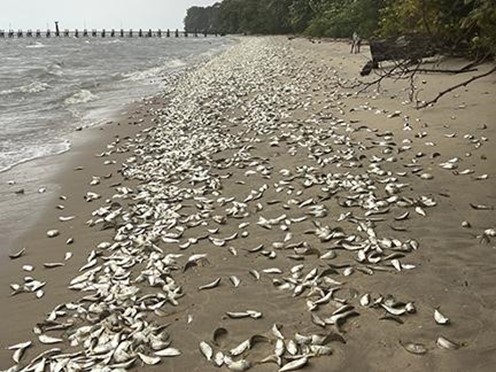Human population growth in the Chesapeake Bay watershed is a significant source of stress on fish and other wildlife. Loss of habitat from development, degraded water quality, exposure to pollution, and effects of climate change such as increased temperatures and lower oxygen levels can increase disease susceptibility in fish. The Aquatic Animal Health Program monitors the health of select fish species and responds to reported disease outbreaks in fish populations.
Striped bass
mycobacteriosis
Health Testing
Stocked Fish
Disease
Investigations
Striped bass mycobacteriosis survey
In the early 1990s a dramatic increase in the incidence of disease in striped bass in Chesapeake Bay was observed by watermen and anglers. Scientists identified this disease as
"mycobacteriosis",a bacterial disease caused by 1 or more species of hardy bacteria. Maryland DNR initiated a health survey of striped bass in 1998 to determine the extent and severity of this disease in the population. Each year additional fish are collected, examined and tested for pathogens and nutritional status.
- The 2 bacterial species most closely associated with disease include
Mycobacterium shottsii and
Mycobacterium pseudoshottsii
- Signs of disease include lesions in internal organs and in the skin, and fish may have a general wasting appearance (emaciated)
- Fish with mild disease may appear healthy on the outside, while fish with severe disease have lesions throughout the body including ulcers in the skin.
- Currently, more than 60% of striped bass from Chesapeake Bay have this disease.
- Mortality in striped bass is linked with mycobacteriosis: chances of survival of fish decrease as disease severity increases.
- Fish exposed to unusually high-water temperatures and low oxygen levels are more susceptible to disease.

| 
|
Health Testing of MD Stocked and Wild Fish
The Maryland Department of Natural Resources (DNR) produces and stocks various fish species in Maryland waters to support recreational fishing and bolster populations in areas where natural reproduction is limited by habitat conditions. Prior to scheduled stocking events, hatchery managers coordinate with the Aquatic Animal Health Laboratory (AAHL) to conduct health screenings, ensuring that fish do not introduce harmful pathogens into the wild. In addition to hatchery-raised fish, wild fish are sometimes relocated to other waterbodies to enhance populations for ecological and recreational benefits. These fish must also undergo health screenings before translocation. To facilitate this, biologists either transport a representative sample to AAHL or conduct the screenings in the field when necessary.
- Hatchery fish can carry pathogens (viruses, bacteria, parasites) that are not present in the wild population.
- Testing ensures fish are healthy and have the best chance of survival when either stocked or translocated.
- Regular inspections and testing help monitor the health of hatchery fish and detect any disease outbreak early, allowing for a timely intervention to prevent widespread issues and loss of fish.
- Stocked species include Rainbow, Brown, and Golden trout, Largemouth bass, American and Hickory shad, and others.
Trout are collected from the Savage River and tested for pathogens.
Fish Kill/Disease Investigations
The Maryland Department of the Environment (MDE) has the mandate to investigate fish kill events in Maryland. Since the 1980s, the Aquatic Animal Health Laboratory (AAHL) has provided MDE with pathology and disease diagnostic support to determine the cause of fish kills.
- Fish kills can be caused by various factors, including pollution, disease, and unusually low oxygen levels.
- Field investigations may reveal sufficient environmental information to determine probable causes, but more detailed examinations of fish are often necessary.
- Diagnostic services provided by AAHL may identify the responsible pathogen for infectious diseases or provide support for non-infectious causes of death.
- Large-scale events may involve hundreds of thousands of fish.
 Atlantic menhaden fish kill along Holliday Beach, Calvert County August 2025
Atlantic menhaden fish kill along Holliday Beach, Calvert County August 2025